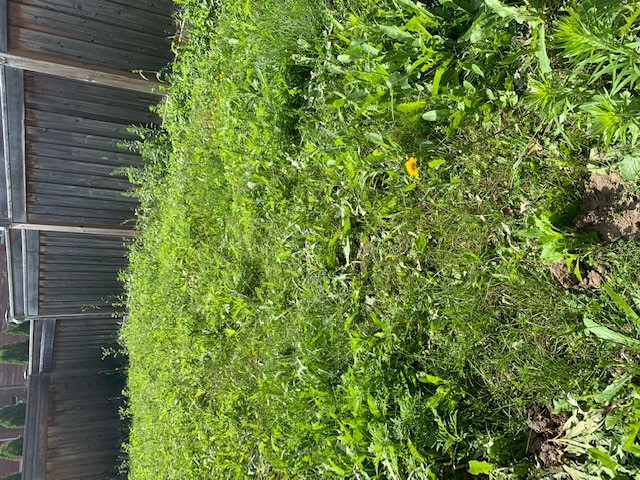
Hello there,
I have recently moved to the Stouffville area (10th line and Main Street) and my backyard is extremely weed infested. We have tried a few methods and have failed. I just feel extremely discouraged and demotivated.
What we have tried so far:
– We have removed a ton of weeds with a deweeding tool (close to 20 bag full)
– however after a week or so strong weeds would come back stronger and taller than before (please see picture for reference)
I am very open and grateful for any idea you may suggest. I have a dream that one day I will have a beautiful lawn but until then I am hoping to get the chance to work towards one.
Best Regards,
David
Thank you for contacting the Toronto Master Gardeners regarding your lawn.
It is very discouraging not to see improvement after so much hard work. I know that area quite well and it seems that most of the lawns up there have weed issues. The area has numerous open fields just, plus neigbours that allow their weeds to go to seed. The lawn is just doomed.
You can try using either black tarp or clear plastic film; both will work, as they aim to kill weeds using different means. Black is used where the intent is to starve the weeds to death by preventing them from photosynthesizing, while clear plastic is used where you want to “cook” the weeds to death. Please take a look at the following answer for further information on both processes:
“Covering the ground with thick black plastic is an effective way to kill weeds. At first the weeds will begin to grow rapidly due to the heat under the black plastic however over time they will die from lack of food. Essentially, the weeds will starve since they cannot produce food through photosynthesis and eventually will exhaust their food supply and starve. This method takes time and will only work as long as no light reaches the plant.
Another effective non-chemical technique to eradicate weeds is through solarization. According to the University of California Integrated Pest Management
“The method involves heating the soil by covering it with clear plastic for four to six weeks during a hot period of the year and when the soil will receive the most direct sunlight. Plastic tarps allow the sun’s radiant energy to be trapped in soil, heating the top 12 to 18 inches to temperatures lethal to a wide range of soilborne pests; including weeds, plant pathogens, nematodes, and insects. When properly done, the top layers of soil will heat up to as high as 140°F, depending on the geographic location. Soil moisture is important in this process, as wet soil conducts heat better than dry soil. Moisture also makes soil pests, weakened by the heat, more vulnerable to attack by beneficial soil microorganisms during and after treatment.”
In addition, solarization stimulates the release of nutrients from organic matter present in the the soil. It is especially effective for treating garden soils, where the intent is to plant vegetables, herbs, and flowers.”
You may wish to start from scratch and remove the lawn and replace it with new sod. The following information is from one of our earlier posts:
“Once the sod is removed you will need to add a layer of good topsoil approximately 10-20cm. Mixing this into the subsoil will improve drainage and improve the quality and texture of your soil by adding more orgainc matter to support the lawn’s roots. Rake and level the area. Apply a seed and sod fertilizer- this is a fertilizer that is high in phosphorus to encourage root development.
Once the sod is delivered, do not leave it exposed to the hot sun- it will dry out and die. You should stagger the rows, laying the sod in a brickwork pattern. The edges of the sod should butt right up against each other; do not overlap the pieces or leave gaps inbetween.
Make sure to water your new lawn immediately and generously. Make sure that the water penetrates the sod and reaches the soil line. New sod needs to be moist until it’s established. The frequency of watering depends upon the weather and soil type. You will know that the new sod has taken when you can no longer lift a piece off the ground.
Remember to keep off the newly sodded area for as long as possible since walking on it will compact the soil. A new lawn can be mowed in as little as 7 days. There is no need to fertilize your lawn until its mature.
Landscape Ontario has some excellent information on care of your lawn: How to Care for your Lawn, How to Maintian a Healthy Lawn, Landscape with Turfgrass.”
Lastely you may wish to consider getting rid of the lawn all together and planting groundcover or a pollinator garden. There is a wealth of information on our website for lawn alternatives, simply type lawn alternative into the Find It Here search box located on the right side of the torontomastergardeners.ca page. The following link brings you to a number of archived responses concering planting a pollinator garden.
July 30, 2021

